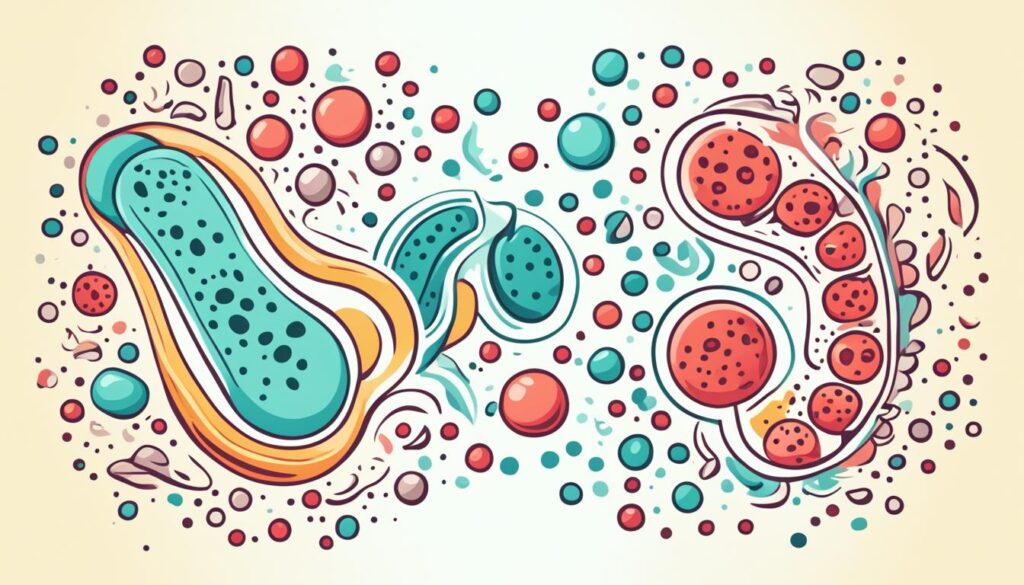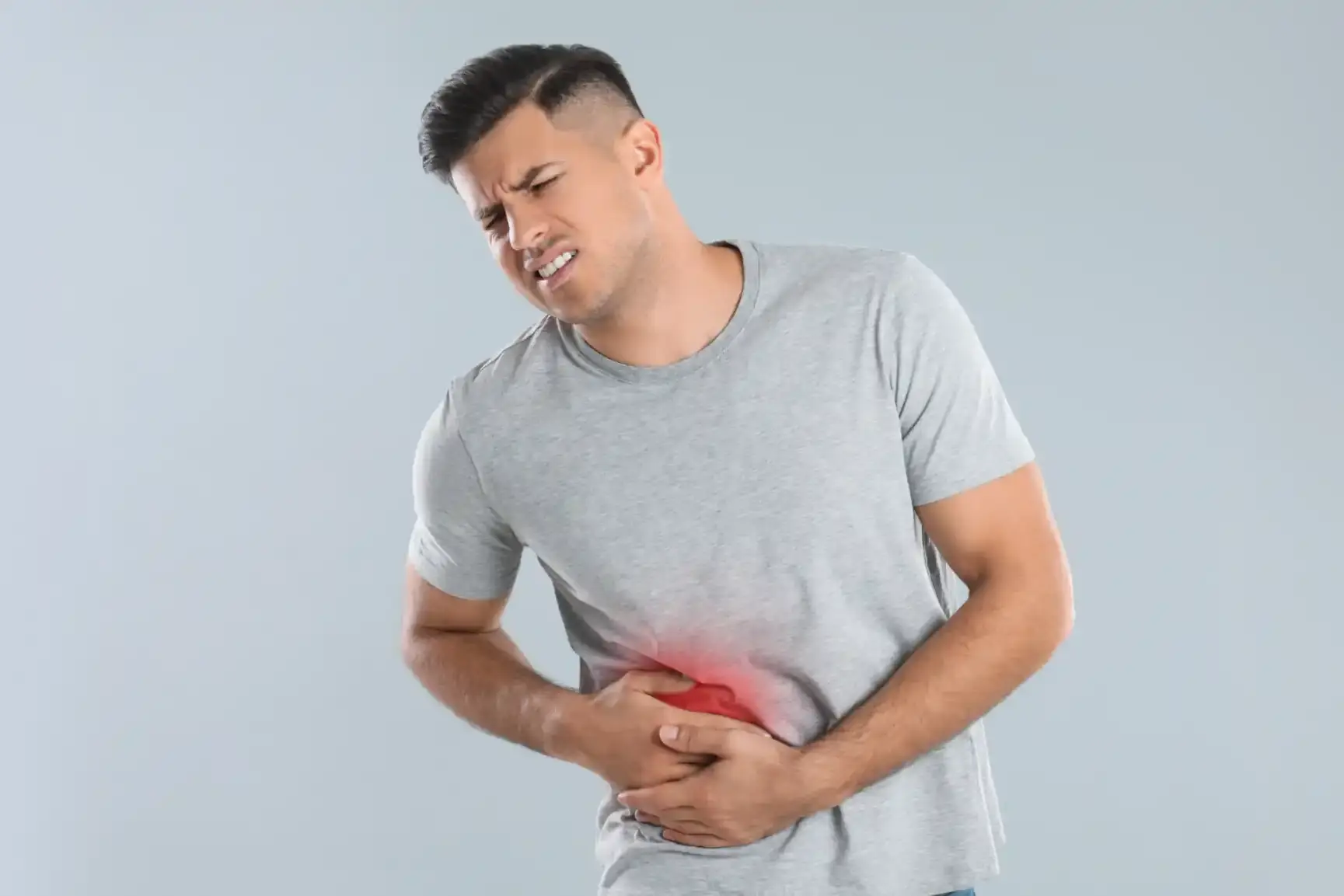Gastric ulcers form in the stomach’s lining. Duodenal ulcers are in the duodenum, which is the first part of the small intestine. They both cause a burning or dull pain in the abdomen. But, their pain might feel different and happen at different times. Gastric ulcers hurt more on an empty stomach. Duodenal ulcers hurt more after eating.1
Table of Contents
TogglePeptic ulcers can lead to serious problems if not treated. These problems include stomach cancer and bleeding. It can also cause the digestive tract to become blocked. The risks and complications are not the same for gastric and duodenal ulcers.
It’s important to know the differences between these ulcers for proper diagnosis and treatment. Working with your doctor is key to finding the best care. Together, you can treat the ulcers, help them heal, and stop them from coming back.
Understanding Peptic Ulcers
Definition of Peptic Ulcers
Peptic ulcers are sores that form in the stomach or upper part of the small intestine. They happen when the lining of the digestive system gets hurt. This can create painful sores.
Types: Gastric and Duodenal Ulcers
There are two types of peptic ulcers: gastric and duodenal. Gastric ulcers are in the stomach’s lining. Duodenal ulcers are in the small intestine’s first part, called the duodenum. Sometimes, a person can have both types at once, which we call gastroduodenal ulcers.
Causes of Gastric and Duodenal Ulcers
An infection with H. pylori bacteria is the major cause of peptic ulcers. This bacteria harms the stomach and duodenum linings’ protective mucus. It allows stomach acid to hurt them, causing ulcers.
Role of H. pylori Bacteria
About 30 to 40 percent of Americans have H. pylori. It’s the top reason behind ulcers. Most people with these ulcers, about 75 percent, don’t feel symptoms.
Impact of NSAIDs and Medications
NSAIDs like aspirin and ibuprofen can damage the stomach lining. After getting H. pylori, using NSAIDs is a big risk for ulcers.
Others like osteoporosis meds and anticoagulants also up your ulcer risk.
Other Contributing Factors
Bad genes, smoking, and Zollinger-Ellison syndrome may lead to ulcers. Old age, heavy drinking, and past ulcers also make you more likely.
Spicy foods are not directly linked to ulcers. But they might upset sensitive stomachs. Some meds for osteoporosis and SSRI antidepressants raise ulcer chances.
If you get diagnosed with H. pylori, make sure to finish all your antibiotics. This reduces your ulcer risk. Staying active helps your body fight off ulcers too.

Difference between gastric and duodenal ulcer
Location: Stomach vs. Duodenum
Gastric and duodenal ulcers are in different spots in the gut. Gastric ulcers are in the stomach lining. Duodenal ulcers are in the duodenum, the top part of the small intestine. Where they are found can change the symptoms in how bad and when they show up.
Symptom Variations
Both ulcers can make your belly hurt, like with a burn or dull pain. But when this pain happens can help tell them apart. A stomach with a gastric ulcer might hurt more when it’s empty. Yet, a duodenal ulcer may cause more pain after you eat. Plus, with a duodenal ulcer, you might feel worse a few hours after meals.
Risk Factors and Complications
The dangers and problems from these ulcers differ. Gastric ulcers have a bigger link to stomach cancer. But, duodenal ulcers are not as often tied to cancer. If you don’t treat either type, they can cause severe issues. These include bleeding, making holes, or blocking your gut.
Diagnosis and Testing
To find out if someone has gastric or duodenal ulcers, doctors do a lot of things first. They talk to the patient about any pain, medicine, and family history of ulcers. They also do a physical exam.
Medical History and Physical Examination
Doctors often spot peptic ulcers by checking a person’s medical and family history. They also look at the patient and run some tests.
Endoscopy and Biopsy
An endoscopy is a key test for ulcers. It uses a long, thin tube with a camera to look inside the patient’s throat, stomach, and upper intestine.
The doctor may take a small piece of tissue (biopsy) during the endoscopy. They check this sample for H. pylori bacteria.
Other Diagnostic Tests
Doctors also use blood, stool, and breath tests to find H. pylori. Imaging tests like a barium swallow may be done to see the stomach and gut.
Treatment Options
If an H. pylori infection causes the peptic ulcer, doctors use a mix of medicines to fight it. This includes antibiotics to kill the bacteria. They also give drugs to lower stomach acid and protect the digestive tract lining.
Antibiotics for H. pylori Infection
The usual treatment for H. pylori ulcers needs two or more antibiotics. Doctors may use meds like amoxicillin, clarithromycin, or metronidazole. They also give a proton pump inhibitor (PPI) or H2-receptor antagonist. This mix of drugs fights the H. pylori bacteria and helps the ulcer heal.
Acid-Reducing Medications
Proton pump inhibitors (PPIs) and H2-receptor antagonists are key in peptic ulcer treatment. PPIs lessen stomach acid while H2-receptor antagonists drop acid levels too. These drugs aid ulcer healing and stop more stomach or duodenum lining harm.
Lifestyle Modifications
Along with meds, certain lifestyle changes improve peptic ulcer healing and stop them from coming back. This means no NSAIDs, stopping smoking, cutting back alcohol, and steering clear of ulcer-aggravating foods.
Conclusion
Gastric and duodenal ulcers both cause a lot of pain and can become serious if not treated. Knowing the key differences helps in their diagnosis and care. Working with a doctor is crucial for the right treatment and to stop the ulcers from returning.
Peptic ulcers are quite common. In 2015, about 87.4 million people got new cases worldwide. These ulcers can be dangerous if not treated well, causing 267,500 deaths in 2015. It’s essential to know the differences and get help quickly to protect your health.
A team of experts is studying gastric and duodenal ulcers closely. They come from organizations like the American Association for the Study of Liver Diseases.6 Their work helps doctors and patients understand and treat peptic ulcers better.
FAQ
What is the difference between a gastric ulcer and a duodenal ulcer?
Gastric ulcers are in the stomach lining, and duodenal ulcers are in the duodenum. This makes their symptoms and times of pain different.
What are the common symptoms of gastric and duodenal ulcers?
Both ulcers cause a burning pain in the abdomen. Gastric ulcers hurt more on an empty stomach. Duodenal ones can be painfull after eating.
What are the main causes of peptic ulcers?
Peptic ulcers are often due to H. pylori bacteria. Using NSAIDs for a long time also raises the risk.
How are gastric and duodenal ulcers diagnosed?
Endoscopy is key for diagnosis. It looks at the esophagus, stomach, and duodenum. Tests for H. pylori, like blood and breath tests, also help find the cause. So do imaging tests.
How are peptic ulcers treated?
Treating an H. pylori infection and cutting stomach acid are the first steps. This includes antibiotics and protective stomach medicines. Lifestyle changes, like no NSAIDs and no smoking, are also important.
Source Links
- https://www.hopkinsmedicine.org/health/conditions-and-diseases/stomach-and-duodenal-ulcers-peptic-ulcers
- https://www.healthline.com/health/gastric-and-duodenal-ulcers
- https://www.medicalnewstoday.com/articles/322849
- https://www.niddk.nih.gov/health-information/digestive-diseases/peptic-ulcers-stomach-ulcers/diagnosis
- https://en.wikipedia.org/wiki/Peptic_ulcer_disease
- https://emedicine.medscape.com/article/181753-overview
About The Author

This article is medically reviewed by Dr. Nivedita Pandey, Senior Gastroenterologist and Hepatologist, ensuring accurate and reliable health information.
Dr. Nivedita Pandey is a U.S.-trained gastroenterologist specializing in pre and post-liver transplant care, as well as managing chronic gastrointestinal disorders. Known for her compassionate and patient-centered approach, Dr. Pandey is dedicated to delivering the highest quality of care to each patient.
→ Book a consultation to discover which remedies suit your needs best.
About Author | Instagram | Linkedin





